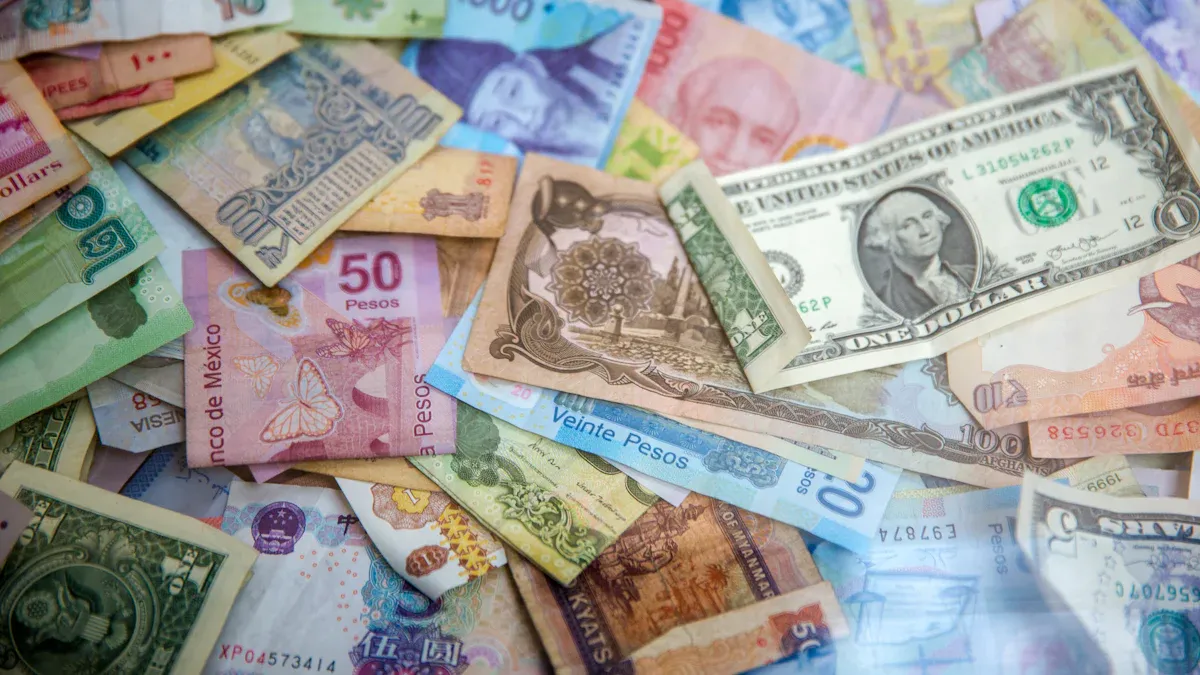- EasyCard
- Trade
- Help
- Announcement
- Academy
- SWIFT Code
- Iban Number
- Referral
- Customer Service
- Blog
- Creator
Analysis of Citibank's International Remittance Fees: Guide to Transfer Costs, Discounts, and Refunds

Image Source: pexels
You need to understand that the total cost of a Citibank international remittance consists of three core components: transaction handling fees, exchange rate markups, and possible intermediary bank fees.
Citibank processed nearly $380 billion in cross-border transactions in 2024, with an average transfer amount of $7,000. Your specific fees vary significantly based on account tier and transfer method. For example, higher-tier accounts often enjoy fee waivers.
Key Points
- Citibank international wire transfer fees include transaction handling fees, exchange rate markups, and intermediary bank charges.
- Upgrading your Citibank account tier can reduce or eliminate transfer handling fees.
- Using “Citibank Global Transfers” to other Citibank accounts is typically free.
- Carefully verifying recipient information before transferring is crucial to avoid failures and refund issues.
- Beyond handling fees, you need to consider exchange rate costs, as banks add profit margins to rates.
Comprehensive Analysis of Citibank International Wire Transfer Costs

Image Source: unsplash
To accurately calculate your total transfer cost, you need to examine three key fees separately. These fees collectively form the total amount you pay. Let’s break them down to help you clearly understand where every cent goes.
Transaction Handling Fees
Transaction handling fees are fixed service charges for processing your transfer request. These fees are transparent but vary based on your account tier and transfer type (outgoing or incoming).
Outgoing Wire Fees
When sending money overseas from Citibank, the bank charges an outgoing fee. Higher-tier accounts benefit from significant fee reductions or exemptions.
Below is a comparison of international wire outgoing fees by account tier:
| Account Type | Fixed Fee (USD) |
|---|---|
| Citigold® Private Client | $0 |
| Citigold® | $25 |
| Citi Priority | $25 |
| All Other Accounts | $35 |
Incoming Wire Fees
When receiving an international transfer, Citibank may charge an incoming fee. Higher-tier accounts typically waive this fee.
| Account Type | Incoming Fee (USD) |
|---|---|
| Citigold®, Citi Alliance, Citigold® Private Client | $0 |
| Citi Priority | $0 |
| All Other Accounts | $15 |
Pro Tip: If both you and the recipient have Citibank accounts, prioritize using “Citibank Global Transfers.” Transfers to Citibank accounts in the U.S. or designated countries/regions like Hong Kong and Singapore are typically free, saving you significant handling fees.
Exchange Rate Costs
Exchange rate costs are the most hidden yet impactful fee in Citibank international transfers. The rate provided isn’t the real-time mid-market rate but a “posted rate” including the bank’s profit margin. This difference is your hidden cost.
The bank’s rate markup is typically 2-3%, and in some cases, can reach 4-6%. This means for every $10,000 transferred, you could pay an additional $200 to $300.
You can assess this cost with these steps:
- Check Citibank’s Daily Posted Rate: Log into online banking or the app to view the target currency’s “sell rate” on the international transfer page. This is the price the bank sells foreign currency to you.
- Check Real-Time Mid-Market Rate: Use Google, Reuters, or XE to check the real-time rate at the same time.
- Calculate Rate Margin: Compare the bank’s sell rate to the mid-market rate. The difference is the bank’s profit and your actual cost.
For example, the posted rate might look like:
| Currency | Bank Buy Rate (USD) | Bank Sell Rate (USD) |
|---|---|---|
| GBP | 1.2180 | 1.2290 |
| EUR | 1.0820 | 1.0935 |
If transferring GBP, focus on the bank’s “sell rate” (1.2290). If the mid-market rate is 1.2100, the difference is your rate cost.
Intermediary Bank Fees
When making a Citibank international transfer, funds typically don’t go directly to the recipient’s bank. They pass through the SWIFT (Society for Worldwide Interbank Financial Telecommunication) network, which may involve one or more “intermediary” or “correspondent” banks.
These intermediary banks charge a service fee for processing your transfer, known as the intermediary bank fee.
- Fee Amount: Typically ranges from $10 to $100, depending on the complexity of the transfer path.
- Payment Method: This fee is usually deducted from your transfer principal, resulting in the recipient receiving less than you sent. In some regions (e.g., Hong Kong), you can choose the “OUR” instruction, paying all intermediary fees to ensure the recipient gets the full amount.
Important Note: Intermediary fees are unpredictable. Banks can’t provide exact amounts upfront, as they depend on other banks in the transfer path. Be prepared for the possibility of a slightly reduced received amount.
Effective Strategies to Reduce Transfer Costs

Image Source: unsplash
Having understood Citibank’s international transfer cost structure, you can adopt proactive strategies to significantly lower total costs. Optimizing your transfer method not only saves money but also improves fund flow efficiency. Here are three proven strategies.
Upgrade Account Tier
Upgrading your Citibank account tier is the most direct way to reduce handling fees. The bank rewards high-net-worth clients with fee waivers. When your assets meet certain thresholds, you automatically qualify for fee exemptions.
- Citigold® and Citigold® Private Client: Holders of these high-tier accounts enjoy multiple fee waivers.
- International wires initiated via online or mobile banking are fee-free.
- Incoming international wire fees are also waived.
- Citi Priority: This tier also waives incoming international wire fees.
Note: Fee waivers typically apply only to self-initiated transactions via online or mobile banking. If you visit a branch or request staff assistance, service fees may still apply.
To access these benefits, you need to meet asset requirements. Below are asset thresholds for select Citibank tiers:
| Account Type | Initial Requirement (New Clients) | Maintenance Requirement (Existing Clients) |
|---|---|---|
| Citigold | $200,000+ combined average monthly balance within 3 months | $180,000 - $999,999 combined average monthly balance |
| Citi Priority | N/A (consult local branch for specifics) | N/A (consult local branch for specifics) |
Optimize Transfer Method
Citibank offers multiple transfer channels. Choosing the right one can directly save you handling fees. Focus on comparing “Citibank Global Transfers” with “traditional wire transfers.”
- Citibank Global Transfers (CGT): If the recipient also has a Citibank account globally, this is the best choice. Transfers to Citibank accounts in designated countries/regions like the U.S., Hong Kong, and Singapore are typically completely free and faster.
- Traditional Wire Transfer: When the recipient isn’t a Citibank customer, you must use a traditional wire, incurring the handling fees mentioned earlier, rate markups, and potential intermediary fees.
Before initiating, confirm if the recipient uses Citibank. This simple check could save you tens of dollars in fees.
Compare Alternatives
While upgrading your account waives handling fees, you still face rate markup costs. For maximum cost-effectiveness, compare Citibank with professional third-party remittance platforms.
For example, Wise’s core advantage is its transparent fee model. Wise uses the mid-market rate (the rate you see on Google) and charges only a clear, upfront service fee. In contrast, many banks, despite advertising low fees, add undisclosed profit markups to rates, increasing your actual cost.
Let’s see the difference with a specific example. Suppose you’re sending $1,000 from the U.S. to the UK and Eurozone:
| Transfer Details | Amount Received with Citibank | Amount Received with Wise | Savings with Wise |
|---|---|---|---|
| Sending $1,000 to GBP | £798.2 | £806.14 | £7.95 |
| Sending $1,000 to EUR | €898.5 | €907.16 | €8.65 |
| Sending $1,000 to AUD | $1,455.80 | $1,470.85 | $15.05 |
| Sending 1,000 AUD to USD | $662.90 | $670.30 | $7.40 |
Key Consideration: Don’t focus solely on “handling fees” when choosing a service. Include “rate costs” to fully assess total expenses. For large transfers, small rate differences can lead to hundreds or thousands of dollars in cost gaps.
Handling Transfer Failures and Refunds
Even with careful planning, international transfers can encounter issues. Understanding common failure causes and proper resolution processes helps you respond calmly and minimize potential losses.
Common Failure Causes
Most transfer failures stem from incorrect information entry. A minor oversight can cause delays, rejections, or fund returns. Pay special attention to:
- Incorrect SWIFT Code: The SWIFT code is a bank’s unique identifier. A single character error can send funds to the wrong bank.
- Incomplete Recipient Information: The recipient’s full name, account number, and address must be accurate. Any missing or mismatched details may lead to rejection by the receiving bank.
Double-checking these key details before submitting is critical for smooth transactions and fund safety.
| Reason for Double-Checking | Impact |
|---|---|
| Ensures funds reach the correct bank | Prevents misdirected funds or transaction failure. |
| Enhances transaction security | Banks verify identities with details, reducing fraud risks. |
| Avoids processing delays | Accurate details ensure smooth, timely delivery. |
Refund Process and Fees
If you discover errors in transfer details or the recipient claims non-delivery, contact Citibank immediately to initiate a trace or recall process.
Important Note: You must request an investigation within one year of the transfer date. The bank contacts the receiving bank via telex, but Citibank doesn’t guarantee successful fund recovery.
The recall process typically involves:
- Initiate Investigation: Provide transaction details to Citibank’s support team to request amendments, non-delivery claims, or fund recalls.
- Await Processing: Resolution depends on the receiving bank’s cooperation and efficiency, which may take weeks.
- Incur Fees: If you initiated an incorrect transfer, you must agree to cover all related fees. The bank deducts service fees from refunds, with no fixed rate disclosed upfront.
- Rate Risk: If the transfer involves foreign currency, recalled funds are converted back to USD at the current rate. Due to rate fluctuations, your refunded amount may be less than originally sent.
In 2020, Citibank mistakenly transferred hundreds of millions to a company’s creditors, issuing multiple recall notices. This case highlights the complexity of recalls and underscores the uncertainty of fund recovery once sent.
Practical Transfer Information Reference
When preparing for an international transfer, understanding limits and expected delivery times is key to smooth transactions and avoiding delays.
Transfer Limits
Citibank sets international transfer limits based on your account tier. Higher-tier accounts typically enjoy higher or no strict limits.
| Account Tier | International Transfer Limit |
|---|---|
| Citigold®, Citi Alliance, Citi Priority | USD transfer limits may match domestic limits or be unrestricted |
| Citigold® Private Client | Some tiers may have no strict daily limits |
Limits vary by region. For example, Citibank Hong Kong’s online banking daily transfer limit can reach HKD 1 million. Log into your online banking or contact customer service to check your region’s specifics.
Pro Tip: How to increase your transfer limit?
Upgrading your account tier is the most effective way to raise daily or weekly limits. Meeting higher-tier asset requirements automatically grants more lenient limits.
Expected Delivery Time
A Citibank international wire transfer typically takes 1 to 5 business days to reach the recipient’s account. Actual speed depends on multiple factors.
Banks process wire requests only on business days (Monday to Friday). Transfers initiated on weekends or holidays are processed the next business day.
Additionally, the bank’s daily processing cutoff time is critical.
Note the Cutoff Time
Citibank’s international wire cutoff is 5:15 PM Eastern Time. Requests submitted after this are deferred to the next business day, delaying delivery by a day.
To ensure faster delivery, initiate transfers early before the business day cutoff.
Accurately calculating your Citibank international transfer cost requires examining three core elements: transaction handling fees, rate markups, and potential intermediary fees. You can save on handling fees by upgrading your account or using Citibank Global Transfers. However, rate costs remain, with bank rate markups typically 1.0% to 3.0%, a significant part of total expenses.
Action Advice: Before transferring, meticulously verify all recipient details and understand the bank’s refund policy. This helps avoid unnecessary fund losses and delays.
FAQ
How do I find the recipient bank’s SWIFT code?
Check the recipient bank’s official website or call their customer service. To ensure fund safety, confirm the SWIFT code with the recipient before transferring to avoid errors causing failure.
What’s the fastest transfer method?
- Citibank Global Transfers (CGT): If the recipient has a Citibank account, this is the fastest, often instant or same-day.
- Traditional Wire: Typically takes 1-5 business days.
Can I completely avoid intermediary bank fees?
Usually not. These fees are charged by processing banks in the SWIFT network, with amounts and paths unpredictable. In some regions (e.g., Hong Kong), choosing “OUR” allows you to pay all fees to ensure the recipient gets the full amount.
Why does the recipient receive less than I sent?
This is typically due to two costs. Banks deduct these from your principal, reducing the final amount received.
| Deduction Reason | Explanation |
|---|---|
| Intermediary Fees | Incurred during SWIFT network transfers, typically $10-$100. |
| Rate Margin | Bank rates include profit, not the real-time market rate. |
*This article is provided for general information purposes and does not constitute legal, tax or other professional advice from BiyaPay or its subsidiaries and its affiliates, and it is not intended as a substitute for obtaining advice from a financial advisor or any other professional.
We make no representations, warranties or warranties, express or implied, as to the accuracy, completeness or timeliness of the contents of this publication.




Contact Us
Company and Team
BiyaPay Products
Customer Services
is a broker-dealer registered with the U.S. Securities and Exchange Commission (SEC) (No.: 802-127417), member of the Financial Industry Regulatory Authority (FINRA) (CRD: 325027), member of the Securities Investor Protection Corporation (SIPC), and regulated by FINRA and SEC.
registered with the US Financial Crimes Enforcement Network (FinCEN), as a Money Services Business (MSB), registration number: 31000218637349, and regulated by FinCEN.
registered as Financial Service Provider (FSP number: FSP1007221) in New Zealand, and is a member of the Financial Dispute Resolution Scheme, a New Zealand independent dispute resolution service provider.



















